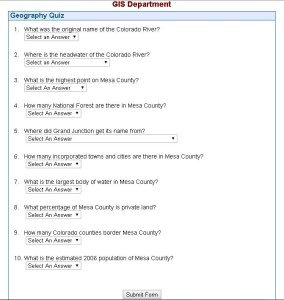
I’ve seen a lot of interesting mapping applications in the news over the last year. One that’s caught my attention is cemetery mapping. I had never really thought about just how ideal a cemetery is to be mapped. Each plot has a distinct spatial location. They have measurable attributes like occupant, location, depth and width. They are often laid out like a grid or a table but sometimes (especially on older properties) they are spread out seemingly without much thought to being easily located again.
Locating a plot is obviously the most important attribute for cemetery mapping. Caretakers have to be able to determine where a body is located so they can avoid accidentally digging it up when placing another body. Relatives of the deceased want to know where their family members are too so they and those in the future can find them again.
One of the first articles I cam across last year was about the cemeteries in the City of Mackinac Island Michigan. The city’s cemetery committee (I bet those meetings are fun) recognized that its current data holdings (hand-drawn paper maps, incomplete lists of cemetery residents and the memories of senior committee members who are increasingly ending up in the cemetery themselves) were not adequate. So they started mapping out plots using GPS and building a database of names.
The City of Mackinac Island Cemetery Committee hopes to have a completed digital mapping system by next June, which will help the city clerk’s office keep track of plots and burials more efficiently. The map is one of many updates the city is considering relating to its cemeteries and burial policies.
It didn’t surprise me to find that some cities are using GIS technology to keep track of cemeteries. What did surprise me was the number of software packages that have been created for mapping and managing them. A quick search for cemetery mapping software reveals several pages of apps, services and companies with interesting names like Memorial Business systems, CemMapper and The Crypt Keeper.
Yet with all of these software solutions, none of the cemeteries that I was interested in searching had detailed mapping of their plots. Only one even had a website. Although the mapping technology is there, this kind of project doesn’t seem like one many cemeteries are willing to undertake.


 To compound things, the quiz was stuck in an enterprise CMS that gave it a really ugly url. I wanted to change that so it would look good and be really easy to understand. Thankfully I wasn’t restricted to any particular language or technology stack to build the new quiz.
To compound things, the quiz was stuck in an enterprise CMS that gave it a really ugly url. I wanted to change that so it would look good and be really easy to understand. Thankfully I wasn’t restricted to any particular language or technology stack to build the new quiz. Conclusion:
Conclusion: